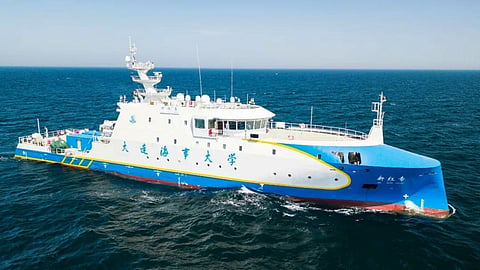VESSEL REVIEW | Xinhongzhuan – Chinese training vessel with intelligent navigation research capability
Dalian Maritime University (DLMU) in China recently took delivery of a new research ship built locally by COSCO Shipping Heavy Industry at its Dalian facilities. The vessel has been named Xinhongzhuan (新红专; “New Hongzhuan) in honour of Hongzhuan, the first training ship to be acquired by DLMU in 1962. The newer vessel is notable for being one of the first in the world to be designed from the outset to combine the functions of training, remote control and monitoring, and intelligent navigation research.
The newbuild has a length of 69.83 metres (229.1 feet), a beam of 10.9 metres (35.8 feet), a draught of 3.5 metres (11 feet), a depth of five metres (16 feet), a displacement of 1,430 tonnes, and accommodation for 15 crewmembers, five scientific personnel, and 30 trainees.
An electric propulsion system comprising three 1,520kW generators driving two 1,500kW podded thrusters delivers a service speed of 18 knots and a range of 2,500 nautical miles. Two bow thrusters provide enhanced lateral manoeuvrability, while stabilising fins help reduce occupant fatigue as scientific missions will be conducted in conditions of up to Sea State Four (up to Sea State Six for normal navigation such as during transits to and from designated research areas).
The ship adopts a backward tilt bow with a hidden bulbous bow, and the hull itself is reinforced in compliance with B-level ice area requirements. Combined with the DP1 system, this ice navigation capability will enable the vessel to safely operate in mild ice conditions independently or moderate ice conditions with external icebreaking support.
The vessel satisfies China Classification Society (CCS) rules covering intelligent ship functions. It is capable of autonomous navigation – either with an embarked crew or fully unmanned – in open water and has the necessary systems for intelligent engine room management and remote control. An integrated automation system collects data from the vessel’s various surface and underwater sensors to provide a more streamlined 360-degree view of the surrounding navigation environment.
Capable of autonomous operation
An intelligent decision-making system utilises existing maritime rules and navigation big data to enable the vessel’s autonomous collision avoidance capability even under adverse weather and sea conditions. The collision avoidance system utilises only radar to detect possible obstacles beyond 12 nautical miles whereas the radar will be supported by AIS and electro-optical sensors for more effective detection, identification and avoidance of obstacles up to 12 nautical miles.
Other capabilities include automatic berthing and unberthing and navigation path optimisation, which will enable the crew to select the most viable routes while also considering parameters such as energy consumption. The entire intelligent platform base also boasts a completely open data interface, thus permitting further development and the integration of new smart devices and intelligent systems that will be available in the future.
Ample laboratory and classroom spaces
Remote monitoring of the vessel and its immediate navigation area can be accomplished from a shore control centre. This facility can also provide additional navigation information and auxiliary decision-making support.
Research activities conducted in the field of intelligent navigation are aided by an onboard laboratory. There is also deck space at the stern for the transport of research instruments as well as unmanned boats and aircraft. The electronics suite meanwhile includes equipment from Intellian.
A multimedia classroom is also available to help train DLMU students in ship operation, particularly the operation of vessels fitted with intelligent systems. The training facilities also allow for reconstruction of maritime scenarios using digital twin technology to enable students to better understand navigation concepts and their applications. All onboard spaces also benefit from wifi connectivity.
Design work on Xinhongzhuan was undertaken by Shanghai Merchant Ship Design and Research Institute (SDARI). Construction of the vessel commenced in May 2023 and was completed in July 2024. The vessel will also be available for use by researchers from other organisations both locally and overseas.


